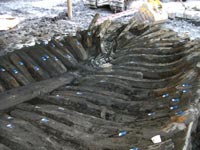 Two weeks ago the remains of an 18th century ship were found in the excavation of the World Trade Center site in Lower Manhattan. On Thursday Warren Riess, an archaeologist specializing in marine history, speculated that the ship was most likely a brigantine; the two-masted workhorse of the coastal trade. “It’s one of the ships that helped build New York.” It also now appears that work on a concrete wall last year may have inadvertently destroyed the after section of the ship.
Two weeks ago the remains of an 18th century ship were found in the excavation of the World Trade Center site in Lower Manhattan. On Thursday Warren Riess, an archaeologist specializing in marine history, speculated that the ship was most likely a brigantine; the two-masted workhorse of the coastal trade. “It’s one of the ships that helped build New York.” It also now appears that work on a concrete wall last year may have inadvertently destroyed the after section of the ship.
A Brigantine Beneath Washington Street
Dr. Riess based some of his preliminary conclusions — and he emphasized that any inferences were tentative — from the opportunity he and his colleagues have had to study the vessel as they disassembled it this week.
What prompted him to suppose the ship was a brigantine were its overall dimensions, he said. The front section of the ship, all that remains, is 32 feet long. Dr. Riess said further investigation might disclose that the vessel was a small three-masted ship or even a large schooner.
Click here for a spherical panorama of the excavation site.
It now appears that the after portion of the ship may have been destroyed when workers poured a concrete slurry wall, inadvertantly cutting the ship in half.
Workmen May Have Accidentally Cut World Trade Center Boat in Half
Construction workers at the World Trade Center may have unwittingly destroyed the 30-foot back section of an 18th century boat that was discovered near the site nearly two weeks ago, archaeologists say.
A report by a team of archaeologists theorizes that the damage to the boat’s aft was done late last year, when Port Authority workers were seeking to mitigate delays caused by the still-standing Deutsche Bank building.
The Port Authority did not see the boat while building the wall last year because they had just dug a narrow trench and poured concrete into it, while now they are doing a broader excavation, said Steve Coleman, a Port Authority spokesman.
David Allen, professor of maritime history at the State University of New York Maritime College, said the entire boat would have offered a more complete picture of its past.
“It’s always helpful to have everything,” Allen said. “Sometimes a lot of artifacts are on one end of the boat and not the other.”
Allen said the captain and officers’ quarters were usually in the back of the boat, while the crew lodged in the front.
“It’s always better to have the entire artifact,” agreed Amanda Sutphin, director of archaeology at the city Landmarks Preservation Commission. “But any part of an 18th-century ship is still great and exciting.”
It is possible that the boat’s rear, or at least pieces of it, could still be buried on the other side of the slurry wall, beneath the Deutsche Bank building, Sutphin said.
